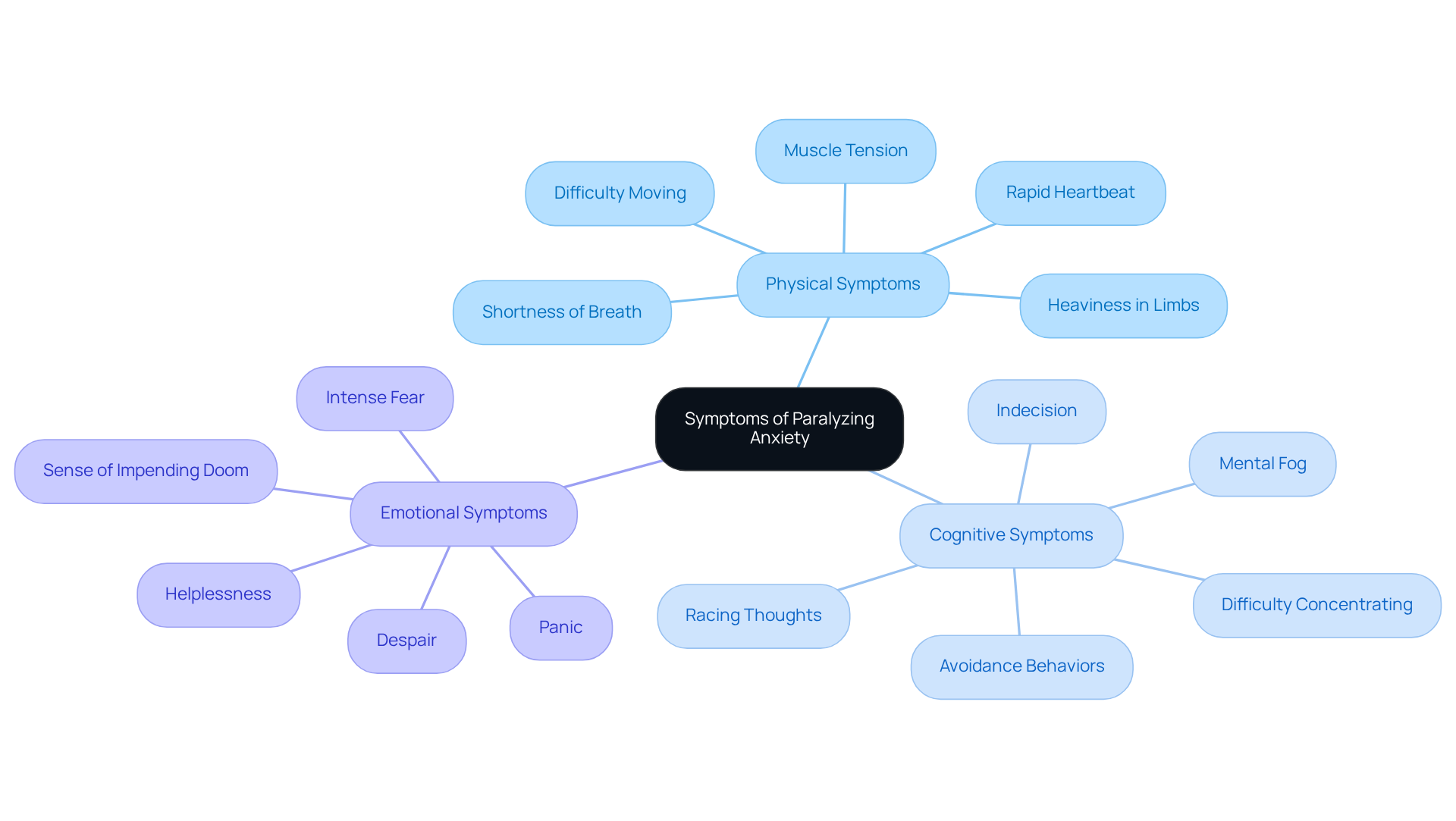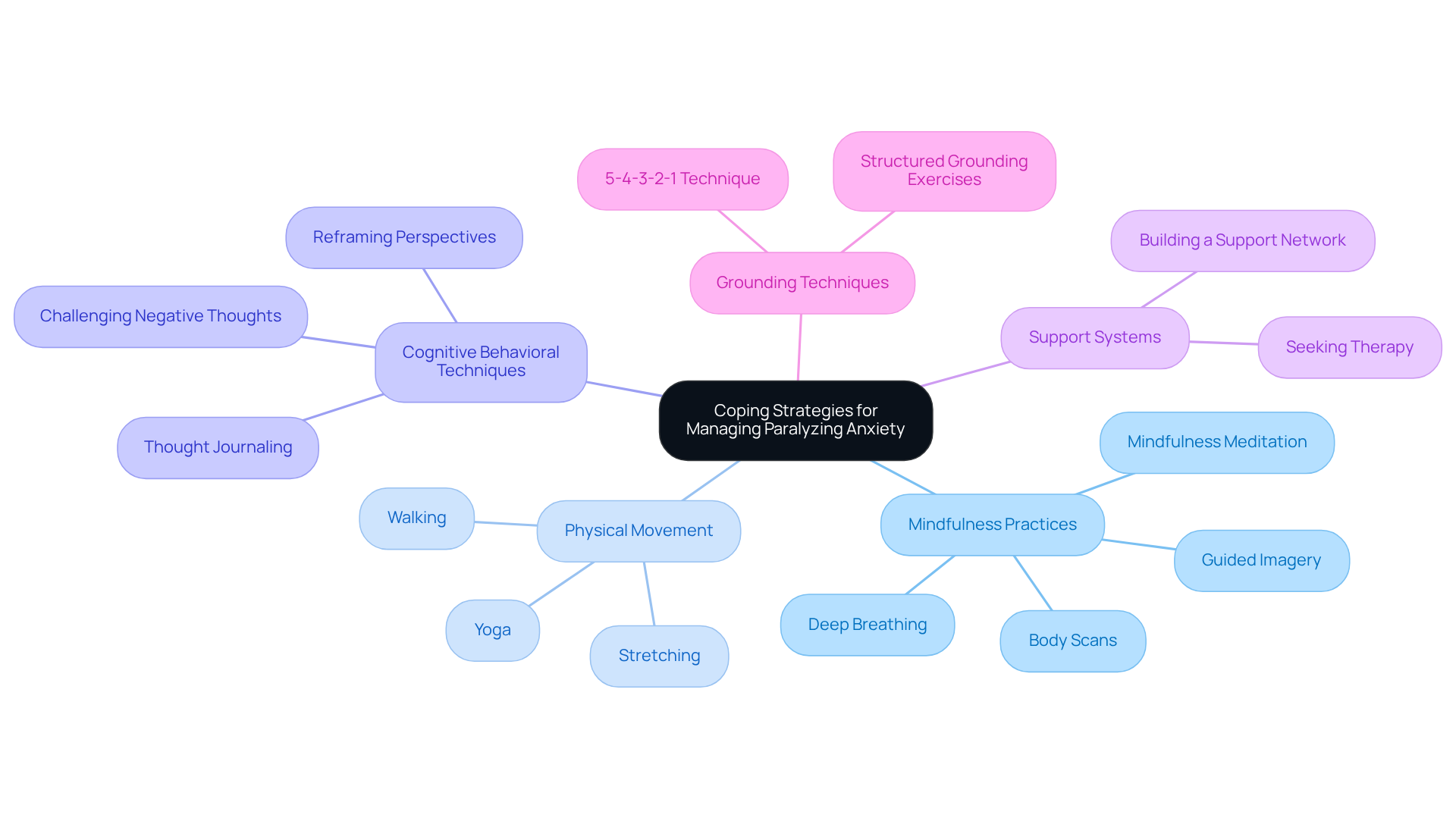Overview
Coping with paralyzing anxiety can feel overwhelming, but recognizing its symptoms and triggers is the first step toward finding effective management strategies. Have you ever felt trapped by your worries? Understanding the nature of this anxiety—along with its physical, cognitive, and emotional manifestations—can empower you to identify your unique triggers.
By adopting coping techniques such as:
- Mindfulness
- Engaging in physical movement
- Leaning on support systems
you can foster resilience and pave the way for recovery. Remember, you are not alone on this journey; seeking help is a courageous and important step.
Introduction
Paralyzing anxiety can grip individuals in a suffocating hold, rendering them unable to function in their daily lives. This debilitating condition, characterized by intense fear and overwhelming distress, often emerges from a variety of triggers, leaving many feeling isolated and helpless. As the prevalence of anxiety-related disorders continues to rise, understanding the symptoms and identifying the root causes become essential steps toward reclaiming control.
Have you ever felt overwhelmed by your past? What strategies can individuals employ to navigate this complex landscape of anxiety and foster a path toward healing? As we explore this further, it's important to recognize that you are not alone in this journey.
Define Paralyzing Anxiety: Understanding Its Nature and Impact
Paralyzing anxiety is a debilitating form of distress that can significantly disrupt an individual's daily functioning. Have you ever felt overwhelmed by a sensation that makes you feel frozen or immobilized? This experience can make it challenging to think clearly, communicate, or take action. Such distress often arises from various stressors, including significant life transitions, traumatic experiences, or prolonged exposure to stress.
Understanding debilitating distress is crucial for recognizing its signs and sources, which can lead to effective coping strategies and therapeutic approaches. Characterized by intense fear and a pervasive sense of impending doom, paralyzing anxiety frequently results in avoidance behaviors and social withdrawal. These reactions can create a vicious cycle, intensifying feelings of isolation and helplessness.
Statistics reveal the profound impact of anxiety-related disorders on daily life; for instance, nearly 22.8% of adults with such conditions experience serious impairment in their daily activities. In addition to this, stress-related disorders are the most common mental health conditions worldwide, affecting around 301 million individuals in 2019.
Psychologists emphasize that debilitating fear can manifest in various forms, including physical signs such as heart palpitations and emotional turmoil, which can hinder one's ability to engage in daily activities. By understanding the nature of debilitating stress and its effects, individuals can better navigate their experiences and seek suitable support. This journey ultimately fosters resilience and recovery, reminding us that healing is possible.
Identify Symptoms: Physical, Cognitive, and Emotional Manifestations
Paralyzing anxiety can present itself in various distinct forms, affecting individuals on multiple levels. Have you ever felt overwhelmed by your past? You are not alone in this struggle.
- Physical Symptoms: Common physical manifestations include heaviness in the limbs, difficulty moving, rapid heartbeat, shortness of breath, and muscle tension. Many individuals report feeling physically immobilized due to paralyzing anxiety, as if they are unable to respond to their environment. It's important to recognize that stress disorders can result in considerable physical discomfort, with 19.1% of U.S. adults facing such issues each year.
- Cognitive Symptoms: Cognitive manifestations often present as racing thoughts, difficulty concentrating, and a pervasive sense of mental fog. Individuals may find themselves overwhelmed by worries about potential negative outcomes, leading to indecision and avoidance behaviors. Research indicates that cognitive issues are common, impacting a significant portion of individuals with anxiety disorders. As we explore this further, consider how these thoughts may affect your daily life.
- Emotional Symptoms: Emotionally, people may experience intense fear, panic, or a sense of impending doom. These feelings can lead to a profound sense of helplessness and despair, often resulting in paralyzing anxiety that complicates their ability to manage daily challenges. Identifying these emotional signs is vital, as it acts as the initial step toward seeking assistance and applying effective coping methods. Remember, acknowledging these emotions is a courageous first step.
Comprehending these signs is crucial for those dealing with the challenges of debilitating stress. It enables you to pursue suitable assistance and treatments, fostering a path toward healing and hope.

Recognize Triggers: Understanding What Sparks Paralyzing Anxiety
Triggers for paralyzing anxiety can differ significantly from one person to another, yet they often encompass:
- Environmental Stressors: Have you ever felt overwhelmed in crowded places, during public speaking, or in high-pressure work environments? These situations can lead to paralyzing anxiety, especially for overachievers who may struggle to prioritize their own needs. Significant life changes, such as relocating, transitioning jobs, or experiencing loss, can evoke paralyzing anxiety and stir emotions of distress and overwhelm. These feelings may be further intensified by past trauma, resulting in paralyzing anxiety.
- Personal Experiences: Previous traumatic experiences or ongoing stress can heighten sensitivity to certain situations, resulting in paralyzing anxiety.
At The Emerald Couch, we deeply understand that recognizing these triggers is essential for developing personalized coping strategies and seeking appropriate therapeutic support. Our tailored approach ensures you receive the guidance needed to navigate your unique challenges, helping you find safety in your body, home, and life once more. We invite you to take advantage of our free 30-minute consultation to better understand your needs. Most clients begin to feel better or notice some improvement within 4 to 6 weeks. By addressing these triggers, you can work towards managing your stress more effectively.
Implement Coping Strategies: Techniques for Managing Paralyzing Anxiety
To effectively manage paralyzing anxiety, individuals can adopt several compassionate coping strategies that nurture emotional well-being:
-
Mindfulness Practices: Have you ever felt overwhelmed by your thoughts? Engaging in mindfulness meditation can help ground you in the present moment, significantly reducing feelings of anxiety. Techniques such as deep breathing, body scans, and guided imagery not only lessen stress levels but also enhance emotional regulation and self-awareness. Mindfulness encourages you to observe your thoughts and feelings without judgment, fostering a sense of control and clarity. By slowing down your thoughts and creating space for choice, mindfulness enhances your journey towards healing. Research indicates a moderate effect size for mindfulness-based interventions (MBIs) in clinical settings, highlighting their effectiveness.
-
Physical Movement: Incorporating even small amounts of physical activity into your routine can alleviate feelings of paralysis. Activities like yoga, walking, or stretching promote relaxation and help reduce tension. Studies show that consistent physical activity can lead to a notable decrease in distress signs, with significant effect sizes noted in various research.
-
Cognitive Behavioral Techniques: Challenging negative thoughts and reframing them into more positive or realistic perspectives can significantly lessen your distress. Keeping a thought journal can assist in identifying and addressing cognitive distortions, fostering a more balanced mindset. Cognitive behavioral therapy (CBT) has been shown to be effective, often paralleling mindfulness-based approaches in alleviating symptoms of distress.
-
Support Systems: Building a strong support network of friends, family, or mental health professionals is essential for emotional support and encouragement. Seeking therapy can provide you with tailored approaches for managing stress, enhancing your overall coping strategies. Insights from therapists emphasize the importance of having a dependable support network when facing stress-related challenges.
-
Grounding Techniques: Have you ever experienced a moment of panic? Methods like the 5-4-3-2-1 approach can help anchor you in the present. This technique involves identifying five things you can see, four you can touch, three you can hear, two you can smell, and one you can taste, effectively redirecting your focus away from stress. Structured grounding techniques can enhance emotional regulation and provide immediate relief during anxious moments.
By implementing these nurturing strategies, particularly mindfulness practices, you can cultivate resilience and better navigate the challenges posed by overwhelming paralyzing anxiety. Remember, seeking help is a courageous step towards healing.

Conclusion
Paralyzing anxiety can be a significant barrier to daily functioning, often characterized by overwhelming fear and a sense of immobilization. Understanding this challenging condition is essential for those seeking to reclaim control over their lives. Recognizing its symptoms and triggers allows individuals to embark on a path toward effective management and healing.
This article explores the multifaceted nature of paralyzing anxiety, shedding light on its physical, cognitive, and emotional symptoms. It emphasizes the importance of identifying personal and environmental triggers that may exacerbate anxiety. By adopting compassionate coping strategies—such as mindfulness practices, physical movement, and cognitive behavioral techniques—individuals can cultivate resilience and navigate their experiences more effectively.
Ultimately, acknowledging the impact of paralyzing anxiety is a crucial step toward recovery. Have you ever felt overwhelmed by your anxiety? By embracing these coping strategies and seeking support, individuals can foster a sense of empowerment and improve their overall well-being. Taking action, whether through personal reflection or professional guidance, can lead to significant improvements in managing anxiety and enhancing quality of life.
Frequently Asked Questions
What is paralyzing anxiety?
Paralyzing anxiety is a debilitating form of distress that can significantly disrupt an individual's daily functioning, often causing feelings of being frozen or immobilized.
What causes paralyzing anxiety?
It can arise from various stressors, including significant life transitions, traumatic experiences, or prolonged exposure to stress.
What are the signs of paralyzing anxiety?
Signs include intense fear, a pervasive sense of impending doom, avoidance behaviors, and social withdrawal, which can lead to feelings of isolation and helplessness.
How common are anxiety-related disorders?
Anxiety-related disorders are the most common mental health conditions worldwide, affecting around 301 million individuals in 2019, with nearly 22.8% of affected adults experiencing serious impairment in their daily activities.
What physical and emotional symptoms are associated with paralyzing anxiety?
Symptoms can include physical signs such as heart palpitations and emotional turmoil, which can hinder one's ability to engage in daily activities.
How can understanding paralyzing anxiety help individuals?
Understanding its nature and effects can lead to effective coping strategies and therapeutic approaches, fostering resilience and recovery.




